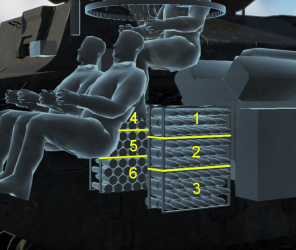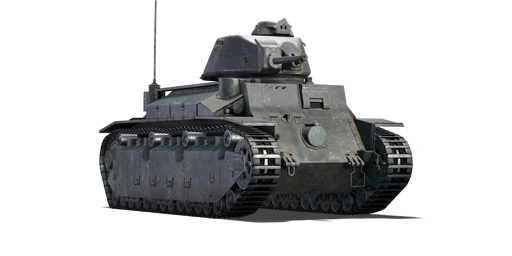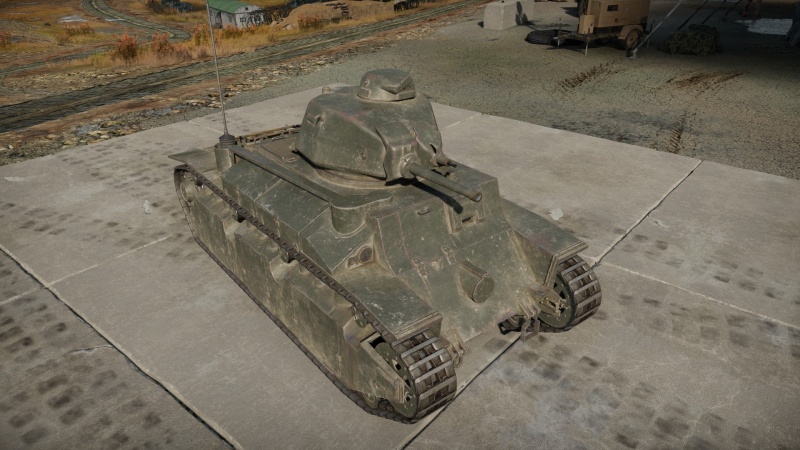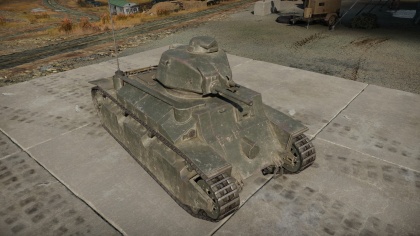Difference between revisions of "D2"
Colok76286 (talk | contribs) (→Pros and cons: Reworded notes) |
|||
| Line 1: | Line 1: | ||
| − | {{Specs-Card|code=fr_renault_d2}} | + | {{Specs-Card |
| + | |code=fr_renault_d2 | ||
| + | |images={{Specs-Card-Image|GarageImage_{{PAGENAME}}.jpg}} | ||
| + | }} | ||
== Description == | == Description == | ||
| Line 9: | Line 12: | ||
== General info == | == General info == | ||
=== Survivability and armour === | === Survivability and armour === | ||
| + | {{Specs-Tank-Armour}} | ||
<!-- ''Describe armour protection. Note the most well protected and key weak areas. Appreciate the layout of modules as well as the number and location of crew members. Is the level of armour protection sufficient, is the placement of modules helpful for survival in combat? If necessary use a visual template to indicate the most secure and weak zones of the armour.'' --> | <!-- ''Describe armour protection. Note the most well protected and key weak areas. Appreciate the layout of modules as well as the number and location of crew members. Is the level of armour protection sufficient, is the placement of modules helpful for survival in combat? If necessary use a visual template to indicate the most secure and weak zones of the armour.'' --> | ||
Sporting 40 mm of rolled armour on all sides of a boxy hull, the D2 can be angled at a perfect 45 degree angle for a consistent effective thickness of at least 60 mm, presenting no obvious weak points save for the turret ring. The turret is of the same general style as used by the S.35 and [[B1 bis]], with a small, strong 56 mm turret face reinforced by two gun mantlets and strongly angled 45 mm sides, making it very effective in hull-down positions. Still beware of enemies behind you and even strafing aircraft, as the low, sloped engine deck has two grilles with a mere 5 mm of protection that even SPAAs and heavy machine guns can penetrate. | Sporting 40 mm of rolled armour on all sides of a boxy hull, the D2 can be angled at a perfect 45 degree angle for a consistent effective thickness of at least 60 mm, presenting no obvious weak points save for the turret ring. The turret is of the same general style as used by the S.35 and [[B1 bis]], with a small, strong 56 mm turret face reinforced by two gun mantlets and strongly angled 45 mm sides, making it very effective in hull-down positions. Still beware of enemies behind you and even strafing aircraft, as the low, sloped engine deck has two grilles with a mere 5 mm of protection that even SPAAs and heavy machine guns can penetrate. | ||
| Line 39: | Line 43: | ||
=== Mobility === | === Mobility === | ||
| + | {{Specs-Tank-Mobility}} | ||
<!-- ''Write about the mobility of the ground vehicle. Estimate the specific power and manoeuvrability, as well as the maximum speed forwards and backwards.'' --> | <!-- ''Write about the mobility of the ground vehicle. Estimate the specific power and manoeuvrability, as well as the maximum speed forwards and backwards.'' --> | ||
| Line 44: | Line 49: | ||
The top speed is poor as the {{PAGENAME}} is heavy: you will often arrive last. Neutral steering is possible and makes turning on the spot easy: this however works only when idle. Once on the move, the {{PAGENAME}} will turn by locking a track. Accelerating and braking happen quickly. Turning doesn't make you lose much speed as your top speed already is slow. The reverse speed is a good point: it will get you out of a dangerous situation quickly. The {{PAGENAME}} reaches 16 km/h when fording, 10 km/h when driving uphill with some speed built-up but a mere 4 km/h uphill from a stop. The tracks are quite large and grant you a decent mobility on hard (solid ground, roads) and soft terrain (mud, snow, sand). Light and medium obstacles (fences, posts, bushes and small trees) are not a problem for the {{PAGENAME}} but large obstacles will reduce your mobility: avoid them. | The top speed is poor as the {{PAGENAME}} is heavy: you will often arrive last. Neutral steering is possible and makes turning on the spot easy: this however works only when idle. Once on the move, the {{PAGENAME}} will turn by locking a track. Accelerating and braking happen quickly. Turning doesn't make you lose much speed as your top speed already is slow. The reverse speed is a good point: it will get you out of a dangerous situation quickly. The {{PAGENAME}} reaches 16 km/h when fording, 10 km/h when driving uphill with some speed built-up but a mere 4 km/h uphill from a stop. The tracks are quite large and grant you a decent mobility on hard (solid ground, roads) and soft terrain (mud, snow, sand). Light and medium obstacles (fences, posts, bushes and small trees) are not a problem for the {{PAGENAME}} but large obstacles will reduce your mobility: avoid them. | ||
| + | |||
| + | === Modifications and economy === | ||
| + | {{Specs-Economy}} | ||
== Armaments == | == Armaments == | ||
| + | {{Specs-Tank-Armaments}} | ||
=== Main armament === | === Main armament === | ||
| + | {{Specs-Tank-Weapon|1}} | ||
<!-- ''Give the reader information about the characteristics of the main gun. Assess its effectiveness in a battle based on the reloading speed, ballistics and the power of shells. Do not forget about the flexibility of the fire, that is how quickly the cannon can be aimed at the target, open fire on it and aim at another enemy. Add a link to the main article on the gun: <code><nowiki>{{main|Name of the weapon}}</nowiki></code>. Describe in general terms the ammunition available for the main gun. Give advice on how to use them and how to fill the ammunition storage.'' --> | <!-- ''Give the reader information about the characteristics of the main gun. Assess its effectiveness in a battle based on the reloading speed, ballistics and the power of shells. Do not forget about the flexibility of the fire, that is how quickly the cannon can be aimed at the target, open fire on it and aim at another enemy. Add a link to the main article on the gun: <code><nowiki>{{main|Name of the weapon}}</nowiki></code>. Describe in general terms the ammunition available for the main gun. Give advice on how to use them and how to fill the ammunition storage.'' --> | ||
{{main|SA35 L/32 (47 mm)}} | {{main|SA35 L/32 (47 mm)}} | ||
| Line 133: | Line 143: | ||
=== Machine guns === | === Machine guns === | ||
| + | {{Specs-Tank-Weapon|2}} | ||
<!-- ''Offensive and anti-aircraft machine guns not only allow you to fight some aircraft but also are effective against lightly armoured vehicles. Evaluate machine guns and give recommendations on its use.'' --> | <!-- ''Offensive and anti-aircraft machine guns not only allow you to fight some aircraft but also are effective against lightly armoured vehicles. Evaluate machine guns and give recommendations on its use.'' --> | ||
Revision as of 09:26, 28 December 2020
Contents
Description
The Char D2 is a rank I French medium tank
with a battle rating of 1.3 (AB/RB/SB). It was introduced in Update "Starfighters". The D2 can be considered the brother of the S.35, sporting similar thick all-around armour, the same 47 mm SA35 gun, and a 3-man crew in the same configuration. The primary differences are the D2 is significantly slower - with nearly half the top speed and a lower power-to-weight ratio - while having a flatter, boxier hull shape, allowing the D2 to angle its armour more reliably.
General info
Survivability and armour
Sporting 40 mm of rolled armour on all sides of a boxy hull, the D2 can be angled at a perfect 45 degree angle for a consistent effective thickness of at least 60 mm, presenting no obvious weak points save for the turret ring. The turret is of the same general style as used by the S.35 and B1 bis, with a small, strong 56 mm turret face reinforced by two gun mantlets and strongly angled 45 mm sides, making it very effective in hull-down positions. Still beware of enemies behind you and even strafing aircraft, as the low, sloped engine deck has two grilles with a mere 5 mm of protection that even SPAAs and heavy machine guns can penetrate.
The D2's ammo racks are located deep in the bottom of the hull, nestled behind the D2's extra suspension armour and the suspension itself, making them fairly well-protected.
Armour types:
- Rolled homogeneous armour (hull, sideskirts, turret ring, turret roof)
- Cast homogeneous armour (turret sides, gun mantlet, turret cupola)
| Armour | Front (Slope angle) | Sides | Rear | Roof |
|---|---|---|---|---|
| Hull | 40 mm (17°) Front glacis - upper part 40 mm (40°) Front glacis - lower part 40 mm (53°) Lower glacis |
40 mm Top 40 mm + 10 mm Bottom |
20 mm (72°) Upper plate (roof) 5 mm (72°) Engine vent (roof) 40 mm Centre plate 20 mm (58°) Lower plate |
20 mm Front part 5 mm Engine vent - front part 20 mm (18°) Rear part 5 mm (18°) Engine vent - rear part |
| Turret | 56 mm Turret front 45 mm Gun mantlet 45 mm Machine gun port 40 mm Turret ring |
45 mm (20°) | 30 mm (25°) Front part 30 mm Rear part | |
| Cupola | 40 mm | 40 mm (26°) | 40 mm (9°) | 30 mm |
Notes:
- Suspension wheels are 15 mm thick, bogies are 10 mm thick and tracks are 20 mm thick
- Lower and upper turret ring armour are both 40 mm thick, and overlap slightly
- Storage boxes, exhaust cover plate and mudguards are 5 mm thick.
Mobility
| Game Mode | Max Speed (km/h) | Weight (tons) | Engine power (horsepower) | Power-to-weight ratio (hp/ton) | |||
|---|---|---|---|---|---|---|---|
| Forward | Reverse | Stock | Upgraded | Stock | Upgraded | ||
| Arcade | 26 | 6 | 19.5 | 232 | 286 | 11.9 | 14.67 |
| Realistic | 23 | 6 | 133 | 150 | 6.82 | 7.69 | |
The top speed is poor as the D2 is heavy: you will often arrive last. Neutral steering is possible and makes turning on the spot easy: this however works only when idle. Once on the move, the D2 will turn by locking a track. Accelerating and braking happen quickly. Turning doesn't make you lose much speed as your top speed already is slow. The reverse speed is a good point: it will get you out of a dangerous situation quickly. The D2 reaches 16 km/h when fording, 10 km/h when driving uphill with some speed built-up but a mere 4 km/h uphill from a stop. The tracks are quite large and grant you a decent mobility on hard (solid ground, roads) and soft terrain (mud, snow, sand). Light and medium obstacles (fences, posts, bushes and small trees) are not a problem for the D2 but large obstacles will reduce your mobility: avoid them.
Modifications and economy
Armaments
Main armament
| 47 mm SA35 L/32 | Turret rotation speed (°/s) | Reloading rate (seconds) | |||||||||||
|---|---|---|---|---|---|---|---|---|---|---|---|---|---|
| Mode | Capacity | Vertical | Horizontal | Stabilizer | Stock | Upgraded | Full | Expert | Aced | Stock | Full | Expert | Aced |
| Arcade | 108 | ±18° | ±180° | Shoulder | 9.5 | 13.2 | 16.0 | 17.7 | 18.8 | 5.2 | 4.6 | 4.2 | 4.0 |
| Realistic | 6.0 | 7.0 | 8.5 | 9.4 | 10.0 | ||||||||
The SA35 gun offers a reasonable penetration power at its battle rating. Its average muzzle velocity allows for a rather flat firing trajectory but the accuracy drop is noticeable from 700 m distance and becomes a handicap over 1,000 m. The rotation speed of the turret is slow compared to other tanks at the same rank or battle rating. Elevation and depression angles of the gun are important, allowing you to fire from unusual positions (behind a ridge, on a slope, etc.). Your recoil is nonexistent. The shoulder-stop stabilizer allows for a good targeting but at very slow speed. The reload times of the gun are in line with other light tanks at the same BR. The average penetration power and the absence of post-penetration damage from the solid shot are the biggest weaknesses of the armament. This will bring you to have to shoot enemy tanks repeatedly to destroy them entirely, while being in close proximity to maximize your penetration power.
Ammunition
The D2 has a limited choice of ammunition:
- Mle1935: APC; a solid shot with average penetration and no explosive filler. Make sure to target modules and crew positions to maximise the damage. Knowledge of enemy vehicle layouts is essential with this type of ammunition.
- Mle1935 HE: HE; useful for destroying open and very lightly armoured vehicles.
| Penetration statistics | |||||||
|---|---|---|---|---|---|---|---|
| Ammunition | Type of warhead |
Penetration @ 0° Angle of Attack (mm) | |||||
| 10 m | 100 m | 500 m | 1,000 m | 1,500 m | 2,000 m | ||
| Mle1935 | APC | 62 | 59 | 47 | 36 | 27 | 20 |
| Mle1935 HE | HE | 4 | 4 | 4 | 4 | 4 | 4 |
| Shell details | |||||||||
|---|---|---|---|---|---|---|---|---|---|
| Ammunition | Type of warhead |
Velocity (m/s) |
Projectile Mass (kg) |
Fuse delay (m) |
Fuse sensitivity (mm) |
Explosive Mass (TNT equivalent) (g) |
Ricochet | ||
| 0% | 50% | 100% | |||||||
| Mle1935 | APC | 660 | 1.62 | N/A | N/A | N/A | 48° | 63° | 71° |
| Mle1935 HE | HE | 590 | 1.41 | 0.0 | 0.1 | 143 | 79° | 80° | 81° |
Ammo racks

| Full ammo |
1st rack empty |
2nd rack empty |
3rd rack empty |
4th rack empty |
5th rack empty |
6th rack empty |
Visual discrepancy |
|---|---|---|---|---|---|---|---|
| 108 | 91 (+17) | 73 (+35) | 55 (+53) | 37 (+71) | 19 (+89) | 1 (+107) | No |
Notes:
- As they are modeled by sets of 3, shells disappear from the rack only after you've fired all shells in the set.
- Packing 25 (+83) shells is a good compromise to have enough shells at your disposal while reducing drastically the risk of ammo rack detonation.
Machine guns
| 7.5 mm MAC 31 | ||||
|---|---|---|---|---|
| Mount | Capacity (Belt) | Fire rate | Vertical | Horizontal |
| Coaxial | 3250 (150) | 1350 | N/A | N/A |
The small caliber of the MAC 31 machine gun makes it largely ineffective against all armoured vehicles but the ones with an open compartment. It still can be used to ping targets as a rangefinding help.
Usage in battles
- Combat tactics
The D2 should be played as a support tank. In an offensive role, you help destroying advancing enemy tanks and capturing objectives. Stay close to the frontline to maximize penetration power, while staying at a distance from enemy tanks (500-700 m) to avoid being flanked or swarmed. When engaging enemy tanks, angle your tank at 45° to maximize your frontal armour. In a defensive role, being at a distance from the frontline will force enemy tanks to drive in the open to get to you. Always play with a nearby obstacle you can use as cover if you get hit and need to repair. Have a planned retreat route as the enemy will try to use artillery or CAS to dislodge you from cover. A good player in a D2 can lock the enemy adance if positioned in a corridor and properly angled. If you try to use the D2 in a different role on the battlefield, you will quickly reach its limits: as a frontline tank, you will take shots from long range tank destroyers that will disable your tank. Your armour is not thick enough for tank destroyers with long guns. You will also be easily flanked by light tanks or armored cars, especially if they swarm you. Only 1-on-1 engagements should be performed in this role. If you attempt to play long range engagements, your short gun will lack accuracy and penetration will greatly drop over distance. Even with your good gun depression allowing you to fire from behind the cover of a ridge, the slow muzzle velocity of your shells will make it difficult to aim at moving targets in the distance.
- Notable enemies
Many enemy vehicles can destroy the D2:
- Long range tank destroyers that can defeat your armour from 1,000 m,
- Frontline and light tanks that manage to flank or get close to you,
- Tanks with HEAT shells,
- Tanks with many crew members: your ammunition having little post-penetration damage, knocking all crew members becomes lengthy.
- How to defeat a D2
In a frontal encounter, shoot right in the middle of the front plate if the D2 did not angle its hull. This will knock out the gunner and the driver. If angled, aim at the turret ring. When flanking, aim for the spot right under the center of the turret or the turret ring (small area).
Modules
| Tier | Mobility | Protection | Firepower | |
|---|---|---|---|---|
| I | Tracks | Parts | Horizontal Drive | |
| II | Suspension | Brake System | FPE | Adjustment of Fire |
| III | Filters | Crew Replenishment | Elevation Mechanism | |
| IV | Transmission | Engine | Artillery Support | |
Pros and cons
Pros:
- Thick all-around armour, able to be heavily angled.
- Good penetration power.
- Shoulder stabilizer.
- 3 crew members, granting better survivability than French rank I 2-man vehicles.
- Quick reverse speed: -12 km/h.
- Neutral steering.
Cons:
- Very low top speed.
- No explosive filler for its AP shells.
- Longer reload than most peers.
History
Design
In 1926, the French Army expressed the need for a new battle tank aimed at replacing all Renault FT tanks. The company Renault proposed a design that would later become the Char D1. While the D1 was still in development in 1930, the French Infantry Command ordered Renault to design a heavier version of the tank: the D2. Like for the D1, the crew consisted of 3 members and the tank was equipped with a one-man Schneider turret. The D2 had to be better armoured and faster than the D1 but was heavier and offered a taller silhouette.
Development
The Char D2 was developed from 1930 to 1933, then tested and accepted by the French Army. Due to interference with the production of the Char D1 and delays in the delivery of Schneider turrets, the D2 was only produced in 1936-37 and later in 1940. The first tanks were equipped with a short 47 mm SA34 gun and the later ones were equipped with the long 47 mm SA35 gun. Shortly before the start of the war, the older tanks were retrofitted with a SA35. Around 100 tanks were produced.
Combat usage
The Char D2 fought during the battle of France in May 1940, most notably at the battles of Montcornet and Amiens. After the defeat, the D2 were scrapped. Only the turrets were reused as fortification guns by the Germans.
Media
- Skins
- Videos
See also
- Vehicles equipped with the same gun
- Other vehicles of similar configuration and role
External links
| France medium tanks | |
|---|---|
| M4 Derivatives | M4A1 (FL10) · M4A4 (SA50) |
| AMX-50 | AMX M4 · AMX-50 (TOA100) · AMX-50 (TO90/930) |
| AMX-30 | AMX-30 · AMX-30 (1972) · AMX-30B2 · AMX-30B2 BRENUS · AMX-30 ACRA · AMX-30 Super |
| AMX-32/40 | AMX-32 · AMX-32 (105) · AMX-40 |
| Leclerc | Leclerc · Leclerc S2 · Leclerc SXXI · Leclerc AZUR |
| Other | D2 · S.35 · Lorraine 40t |
| Germany | Panther "Dauphiné" |
| USA | ▄M4A1 · ▄M4A3 (105) · ▄M4A4 · ▄M26 |






